Orpington: Difference between revisions
m clean up, typos fixed: 10 horsepower → 10-horsepower |
|||
| Line 52: | Line 52: | ||
===Orpington car=== | ===Orpington car=== | ||
The Orpington Car, designed by Frank Smith and built by Smith & Milroy Ltd at their works in Wellington Road, was shown at the 1920 Motor Show. It was a two-seater convertible, with a dickey seat, and a 10 horsepower engine. Although briefly successful, Smith and Milroy could not compete with mass production, and the last car was commonly believed to have been built in 1925. The only known survivor at the time reportedly once appeared in the 1970s television series Crossroads, but this has not been substantiated. There are now no known surviving examples in existence. | The Orpington Car, designed by Frank Smith and built by Smith & Milroy Ltd at their works in Wellington Road, was shown at the 1920 Motor Show. It was a two-seater convertible, with a dickey seat, and a 10-horsepower engine. Although briefly successful, Smith and Milroy could not compete with mass production, and the last car was commonly believed to have been built in 1925. The only known survivor at the time reportedly once appeared in the 1970s television series Crossroads, but this has not been substantiated. There are now no known surviving examples in existence. | ||
===Orpington man=== | ===Orpington man=== | ||
Revision as of 21:23, 27 January 2016
| Orpington | |
| Kent | |
|---|---|
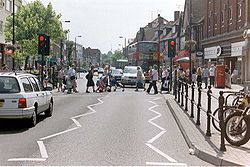 Orpington High Street.jpg | |
| Location | |
| Grid reference: | TQ460660 |
| Location: | 51°22’27"N, -0°5’55"E |
| Data | |
| Post town: | Orpington |
| Postcode: | BR5, BR6 |
| Dialling code: | 01689 |
| Local Government | |
| Council: | Bromley |
| Parliamentary constituency: |
Orpington |
Orpington is a suburban town in Kent. It forms the southeastern edge of London's urban sprawl and is identified by the Greater London Authority in the "London Plan" as one of 35 major centres in its area.[1]
History
Stone Age tools have been found in several areas of Orpington, including Goddington Park, Priory Gardens, the Ramsden estate, and Poverest. Early Bronze Age pottery fragments have been found in the Park Avenue area. During the building of Ramsden Boys School in 1956, the remains of an Iron Age farmstead were excavated. The area was occupied in Roman times, as shown by Crofton Roman Villa, and the Roman bath-house at Fordcroft.[2]
The first record of the name Orpington occurs in 1038, when King Cnut's treasurer Eadsy gave land at "Orpedingetune" to the Monastery of Christ Church at Canterbury. The parish church also pre-dates the Domesday Book.
Until the railway came, the local commercial centre was nearby St Mary Cray, rather than Orpington. St Mary Cray had a regular market, and industry (paper mills and bell foundry), whereas Orpington was just a small country village surrounded by soft fruit farms, hopfields and orchards.
These crops attracted Romani people, working as itinerant pickers, to annual camps in local meadows and worked-out chalk pits. This work has largely ended, but the Borough still provides a permanent site at Star Lane, and the gatherings are commemorated in local street names, such as Romany Rise. In 1967, Eric Lubbock, then Liberal MP for Orpington promoted a private member's bill to provide permanent Gypsy sites; this resulted in the Caravan Sites Act 1968 which placed an obligation upon local authorities to provide sites for locally residing travellers.[3] In 1971, an international meeting of Romany people was held at Orpington, this Orpington Congress marked the founding of the International Romani Union, a group seeking political representation for Romanis throughout Europe.[4]
Parish Church
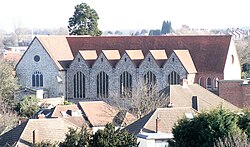
The Parish Church, "All Saints", stands upon pre-Norman foundations. The early church on this site is mentioned in the Domesday Book. The current church is Early English in style, but some Anglo-Saxon work is visible. The church was endowed by the Archbishop of Canterbury in 1173.
The tower and steeple were damaged by a storm in 1771. The rebuilt steeple was struck by lightning in 1809, and it was not replaced. The church was greatly enlarged in 1957.
Retail and commerce
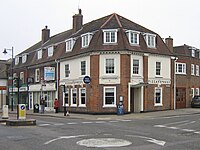
The High Street and adjacent Walnuts Shopping Centre contain a wide selection of high-street shops. There is a general market located in front of Orpington College, three days a week.
Metered parking plagues parts of the street, replacing the old, demolished car park, which has resulted in the exit of some long-established local businesses as the office space they occupied will no longer be feasible without adequate parking. There are larger retail outlets in the industrial estate on Cray Avenue and Sevenoaks Way in St Mary Cray including the new Nugent Shopping Park. Following the relocation of Marks & Spencer from their previous town-centre store to the Nugent Shopping Park, their previous site was taken over by Sainsbury's, who moved from their previous site nearby in the Walnuts.
Places of interest
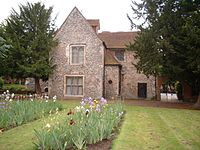
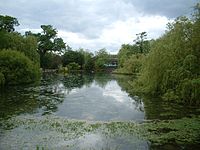
The Priory
The Priory is a fine example of a mediæval 'hall house'. In 1032, Eadsy, chaplain to King Cnut, gave his estate at Orpedingetune to Christ Church Priory, Canterbury. The first Rector of Orpington, Hugh de Mortimer, held court here in 1270. The house was rebuilt, this time of stone, in 1290, and added to in 1393 and 1471. In the 17th century the house ceased to be a rectory and passed into private ownership - a timber-framed extension was added, which no longer exists.
The house was acquired by Orpington Urban District Council in 1947, and now it houses a museum and a public library. The garden forms an attractive public park, and contains a natural pond which is the source of the River Cray. Each year the Orpington May Queen is crowned in the gardens.
Orpington Hospital
During the First World War a large military hospital, the "16th Canadian General", was built south-east of the station, funded by the government of Ontario, Canada. It originally accommodated 1,050 patients; an extra wing was added in 1917. By January 1919, more than 15,000 wounded soldiers had been treated here. Many of the 182 who died are buried in "Canadian Corner" of All Saints' churchyard. Most of the original pre-fabricated buildings remained in use for more than 80 years before a major renovation around the turn of the century.
Orpington in popular culture
Orpington chicken and duck
Orpington is known for the "Buff", "Black" and "Speckled" chickens bred locally by William Cook in the 1890s. The Buff Orpington were able to be seen at Tripes Farm, Chelsfield Lane however, in the late 90s, the chicken coop was removed from the farm. Buff Duck were also developed by Cook.
Orpington car
The Orpington Car, designed by Frank Smith and built by Smith & Milroy Ltd at their works in Wellington Road, was shown at the 1920 Motor Show. It was a two-seater convertible, with a dickey seat, and a 10-horsepower engine. Although briefly successful, Smith and Milroy could not compete with mass production, and the last car was commonly believed to have been built in 1925. The only known survivor at the time reportedly once appeared in the 1970s television series Crossroads, but this has not been substantiated. There are now no known surviving examples in existence.
Orpington man
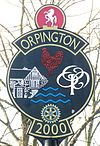
Journalists in the 1960s used "Orpington man" to designate a typical member of the lower middle class, for example as the target audience of an electoral or advertising appeal.[5]
Outside links
| ("Wikimedia Commons" has material about Orpington) |
- 2001 Census information for the Orpington ward at Bromley.org
- Bromley London Borough Council - Orpington town centre Accessed on 1 February 2006
- Orpington Cricket Club
- Website set up by volunteers using historic evidence and copyright free images and pictures
References
- ↑ Mayor of London (February 2008). "London Plan (Consolidated with Alterations since 2004)". Greater London Authority. http://www.london.gov.uk/thelondonplan/docs/londonplan08.pdf.
- ↑ Poverest Road Bath House and Anglo-Saxon Cemetery
- ↑ Stopping Places: A Gypsy History Of South London and Kent Simon Evans (Univ of Hertfordshire Press 2004) ISBN 1-902806-30-1
- ↑ The Roma (Czech Helsinki Committee for Human Rights, October 2002) accessed 3 December 2007
- ↑ David Childs, Britain since 1945 (3rd ed. 1992) pp 140, 146
"Rediscovering... The Orpington Car" by Trevor Mulligan. A 100+ page A5 definitive guide, published 2012.
- Trevor Mulligan (2012). Rediscovering... The Orpington Car. Timeline Books. ISBN 978-0-9573129-0-6.
- Dorothy Cox (1983). The Book of Orpington. Barracuda Books. ISBN 0-86023-164-X.
- John Edwards (1991). A Look Back at Orpington. Bromley Leisure Services. ISBN 0-901002-13-5.
